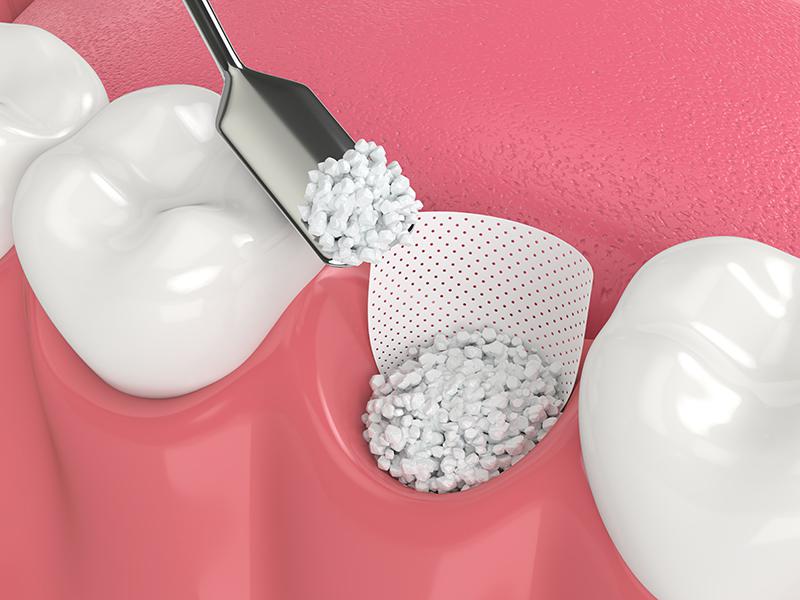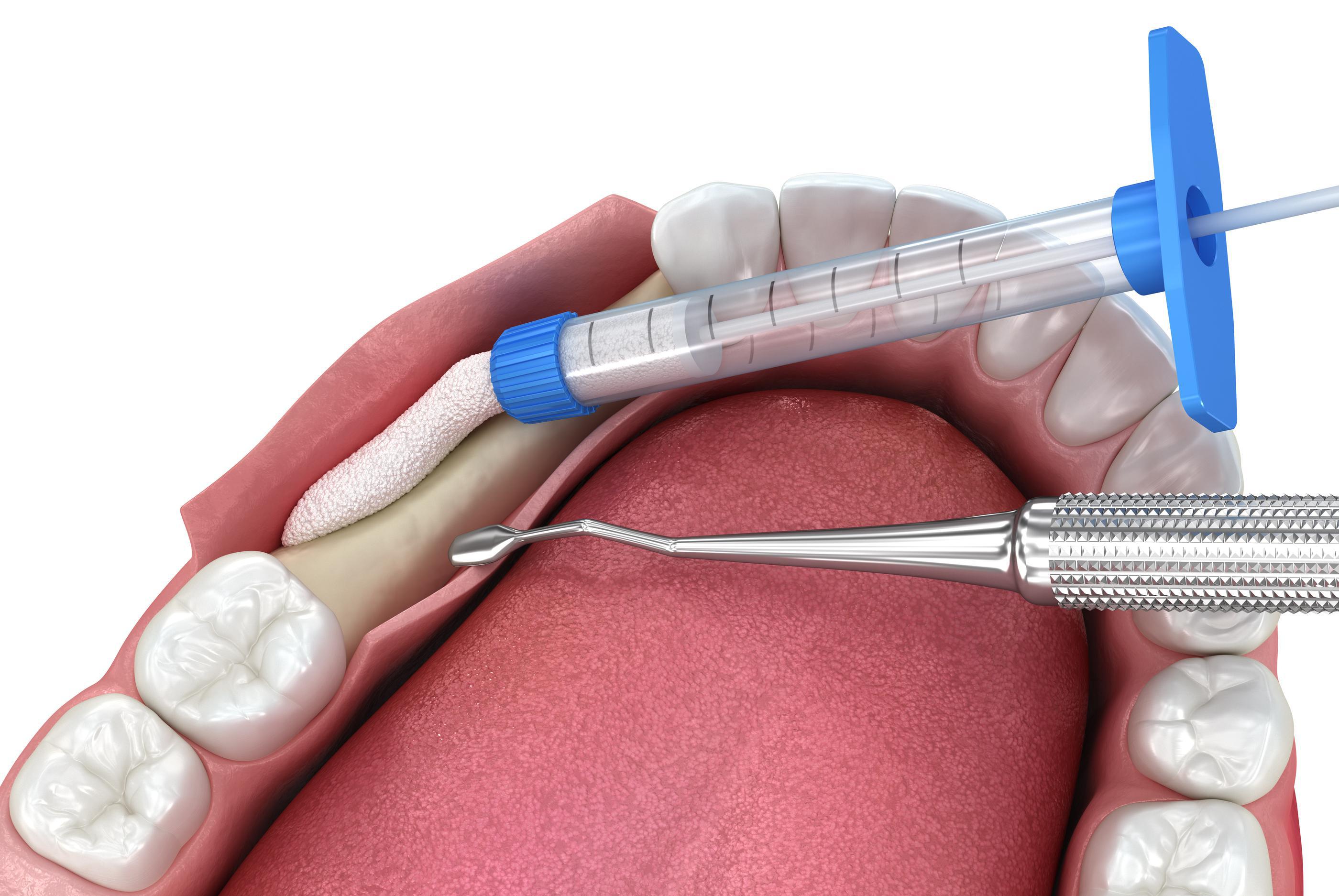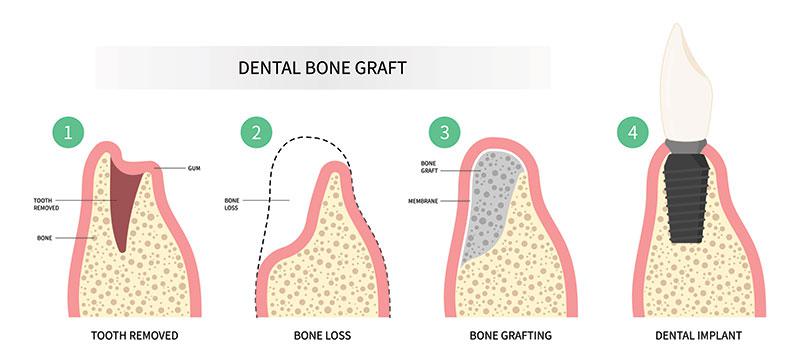 Bone loss can result from missing teeth as the bone in the area of lost teeth undergoes atrophy and is resorbed as it no longer serves its intended purpose. Sometimes, a defect may develop in the bone due to a disease, such as a tumor or a cyst in the jaw that was surgically treated. Bone deficiency may also be a result of trauma, or it can also be a congenital defect. Bone loss or bony defect makes dental implant placement or denture placement difficult. In addition, it also affects facial aesthetics and functions. In such a situation, bone grafting and jaw reconstruction surgeries become essential.
Bone loss can result from missing teeth as the bone in the area of lost teeth undergoes atrophy and is resorbed as it no longer serves its intended purpose. Sometimes, a defect may develop in the bone due to a disease, such as a tumor or a cyst in the jaw that was surgically treated. Bone deficiency may also be a result of trauma, or it can also be a congenital defect. Bone loss or bony defect makes dental implant placement or denture placement difficult. In addition, it also affects facial aesthetics and functions. In such a situation, bone grafting and jaw reconstruction surgeries become essential.
Thanks to the advances in the field of oral and maxillofacial surgery, we now have resources and the ability to replace lost bone and fill in defects with the help of bone grafting and jaw reconstruction surgery.
What is a bone graft?
The primary purpose of a bone graft is to add volume and density to the jawbone and ensure it regains its functionality and aesthetics. A bone graft can be:
- Autogenous - taken from your own body
- Allograft - taken from another human and treated in human tissue banks
- Xenograft - acquired from an animal
- All past - Synthetic bone grafts
Bone grafting is most commonly performed before dental implant placement, as dental implants require a certain bone height and width to be placed successfully. These types of bone grafting surgeries are minor in nature. The bone graft in such a case may be synthetic or may be taken from other areas of the jaw.
However, in cases of significant defects, such as congenital defects, or those that are caused post trauma or after removal of tumor or cyst cannot be replaced by small quantities of bone or synthetic bone grafts. These defects will require jaw reconstruction, and in such case, bone grafts are taken from the patient's own body. These grafts can be taken from the jawbone, hip, ribs, or tibia (leg bone below the knee).

Bone grafts from the jaw
In situations where a small amount of bone needs to be reconstructed, the graft can be obtained from your jawbone. Usually, the bone is acquired from the back region of the upper or lower jawbone behind the wisdom teeth or the chin region. The bone is harvested and placed immediately at the site of the defect and secured using small screws. The bone graft will act as a scaffold and will lead to the formation of new bone in the area. These surgeries are usually performed on an outpatient basis and is done under local anesthesia and sedation.
Bone grafts from the hip
If a larger defect needs to be treated, it will require a larger quantity of bone. In such cases, a bone graft can be taken from the hip, and then it can be molded to fill the defect in the upper or lower jaw. It increases the quantity as well as the quality of the bone. This procedure involves a tiny incision over the hip region, which is used to harvest the hip bone. The harvested bone will be placed in the desired location in the jaws. These surgeries are usually undertaken under complete general anesthesia.
Bone grafts from the Rib and Tibia
Rib bone grafts or costochondral grafts are often taken from the 5th or 6th rib and are often used to reconstruct the jaw joint (temporomandibular joint). Jaw-joint reconstructions are undertaken for the treatment of ankylosis, trauma, and advanced osteoarthritis. They can also be used to seal larger defects left behind after tumor or cyst removal or congenital defects, which leads to a deficiency of the upper or lower jawbone.
Similarly, the tibia (shin bone) can also be used for jaw reconstruction.
Bone grafts substitutes
In some cases, substitutes such as xenografts, allografts, or alloplasts may also be indicated. These grafts can also be combined with your own bone graft to aid the process of new bone formation.
Sinus lift
A sinus lift procedure augments and lifts up the maxillary sinus to make room for a bone graft which eventually leads to the formation of new bone. The maxillary sinuses are air-filled cavities in your upper jaw. Lack of bone makes the placement of dental implants difficult as there are no anchors, which leads to loss of stability, and implants can fail.
Ridge Augmentation
In cases of complete tooth loss, both the upper and lower jaw can undergo significant resorption, which leads to thin bones. In such cases, bone grafts are used to augment the height of the upper and lower ridge of the jawbone for the proper implant and denture placement. Ridge augmentation provides you with the bone structure you lost and restores your appearance, giving you a more youthful glow.
Are you a good candidate for bone grafting and jaw reconstruction?

Any person who is in general good systemic health can opt for bone grafting and jaw reconstruction if needed.
If you have less bone and wish to go for a permanent teeth replacement solution such as dental implants, then bone grafting is the right way for you. Furthermore, if any tumor or pathology has led to a bony defect that affects your appearance and function, bone grafting and jaw reconstruction aid in returning the lost functionality and corrects any facial asymmetry.
Certain congenital or birth defects may lead to the formation of the uneven jawbone or smaller than usual jaws which affect the facial profile as well as functions such as chewing and speech. In such cases, bone grafting can be used to correct the deficit and improve facial height and profile.
Bone loss after teeth loss leads to facial sagging, which gives your face a wrinkled appearance. The lips and cheeks droop as they lose their bony support. In such a situation, reconstructive jaw surgeries not only allow for proper teeth replacement but also restores lost facial proportions, thereby correcting the facial sag and giving a youthful appearance.
If you believe you may benefit from our bone grafting and raw reconstruction surgeries, then it is time to schedule an appointment with our board-certified Oral and Maxillofacial Surgeons today. Our team of excellent and dedicated professionals is here to assist you and your family to better oral and overall health. If you have any more questions or wish to know more about our services, don't hesitate to get in touch with us at Phoenix Oral and Facial Surgery.

